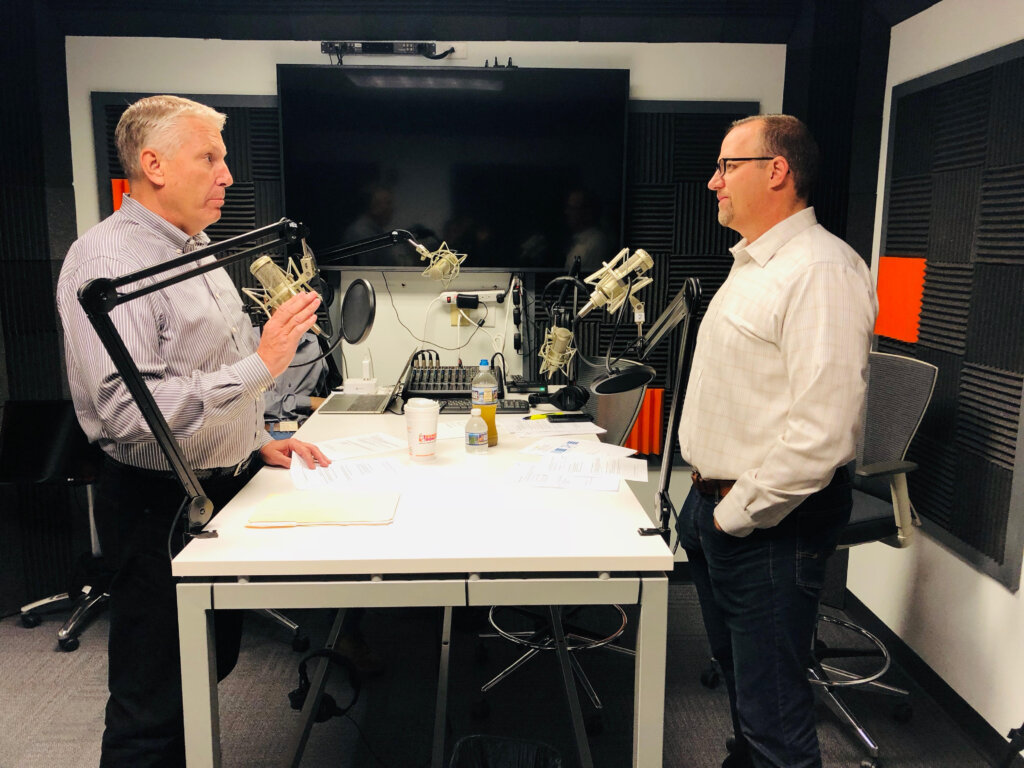Maxwell Executive Leadership Podcast #17: Is it Okay to Be Me?

Authenticity is one of the most important qualities of a leader. In order to be authentic, the first thing you need to do is to really understand yourself so that you can lead and communicate effectively with your team. In Episode 17 of the John Maxwell Company Executive Leadership Podcast, Chris Goede and Perry Holley provide steps that you can take to discover your authentic leadership style, as well as tools that can be used to get there.
Listen to all podcasts in this series and subscribe to new episodes on iTunes– or Google Play.
Read the transcript below:
Welcome to the John Maxwell Company Executive Leadership Podcast where our goal is to help you increase your level of influence, increase your reputation as a leader, and increase your ability to fully engage your team to drive remarkable results. Hi, I’m Perry Holley, a John Maxwell Company facilitator and coach and I’m Chris Goede, Vice President of The John Maxwell Company. Welcome and thank you for joining.
Well, Chris, today we want to talk about the title: Is it okay to be me? And I thought it kind of sounds a little mysterious. Where are you going with this topic? Well, as you probably could guess, you know, authenticity is a big word for us at the John Maxwell Company and I think I’ve maybe even referenced it in the past about a Harvard Business Review study where they looked at 250 CEOs worldwide, men and women, and they were studying trying to find what are the common attributes of leaders that made them successful. And so they took the 250, came up with a list of 18, the number one attribute two to one to number two was authenticity. And so I thought, man, if the top 250 CEOs around the world can lead and be authentic, then we should be doing that, as well.
So it’s definitely about authenticity. And so when you talk about that, you’re like, the first thing I need to do is understand who I am and I need to, I need to know myself so that I can lead and communicate effectively. And with that, we often talk about a couple of different buckets. When you’re leading people, you need to be aware of these buckets. And, so if you’re leading people and you’re aware of these buckets, you probably ought to be aware of them in yourself, as well. The first bucket is really the DNA of how you’re made up. Sometimes, as you know, traveling internationally, speaking to clients, I’ll be in places and I’ll say this, sometimes they don’t understand. So, bear with me. We say this is how your mom and daddy made, right? And they’re like, excuse me, but if I’m in the south, they’re like, we got you. But, really it’s kind of the DNA of who you are and how you were you were wired and made up. The second one is learn behaviors. We all have learned behaviors from internal and external influences and experiences in our life and we bring those with us and our team brings those with them, as well. And we need to be aware of that one as well. And then the third bucket we’ve talked about this in the past is values. It’s kind of your decision making filter. So, I think when you talk about Level 1 influence with people and as you begin your journey as a leader with individuals, because remember, you’re on different levels at all times and so at times you’re going to fall back to Level 1. This is really the foundation here. You truly need to understand yourself in order to become a more effective leader or have more effective influence on people, right?
Well, I always remind the people we coach and the people we see in the workshops hat people are watching you how often, all the time and all the time they’re watching you. Then I just follow up, but what are they watching for? And they always, you know, they’re looking for your actions, your reactions, but they want to know who you are, are you the real deal? Are you living out those values and those behaviors that are driven by your values and so much of the time being authentic as a leader, I just wonder what you think about that. Is the authenticity that when you say be an authentic leader, well absolutely, that’s what I am, but are you really living out who you really are? I just wonder what you see in the and the groups you work with. Where does authenticity come off the rails for a leader? Why does that? It’s not difficult. It’s just sometimes it’s hard to embrace, is it okay to be me? That’s why I liked this title. Is it okay to be me? Are you going to judge me for that?
I think it’s a great question. Here’s something that I’ve noticed. As organizations, we hire people and individuals to play a role and to be themselves and we say to them, we want you to be you. We want you to be the best you. That’s why we’re hiring you. That’s why we want you to be a part of our team. And then we get them into our organization and we begin to try to change them and mold them and they become aware of that. And so then they become less authentic because of our guard rails, our fences that we put around them. And then the other thing I see a lot of, which is a shame, is that I think leaders, the higher they go in organizations and their leadership journey, the less authentic they become. Right, And that just hurts my heart.
Me too, and I’ve, I’ve seen it in myself. It’s what Reebok had a years ago, they had an ad that just said three had three letters: you be you. And, that would cause all the newspaper prints and when I took it out and put it near my desk, just remind me. Yeah, it’s okay. Just you be you, be you. And I thought, why do I have to put on this mask to play in this room? I don’t know. The more I’m taking off, the better people respond to me and the more I get done. That’s right.
So, we have a tool to move forward a little bit. We talk about discovering your authentic leadership style and who are you? Why don’t you tell us a little about how we use that in the 5 Levels workshops and in the Authentic Self workshops. Yeah. One of the things that we want to make sure that Perry and I do and then the John Maxwell Company is that we provide tools and applications for you to further your journey as a leader. And so this is, John says, Hey, this is where it starts. It starts with self. We want to be able to kind of introduce this tool to you. We have a great partnership with RightPath, and it’s really a behavioral assessment that we use. There’s many of them, many good ones out there’s Disc and Myers-Briggs and different ones.
This one really is kind of your behavior and it breaks it down into 16 different personalities and kind of ties a name to you, right? It’s funny. You guys can’t see this, but here in studio as part of our notes Perry prepared, he made sure he put his RightPath in there and he’s a networker by 16 personalities. You’re actually going to be an intervention and we’re going to dive in and we’re going to tell them what’s wrong with them.
But here’s why this is important. Not only do you as a leader, again, everything that we’re sharing here about you remember, can be used with understanding your team as well. And we’re going to talk a little bit about the power of that in just a minute, but you need to understand that man, this is how you’re wired. When you’re backed into a corner, your learned behaviors go out the window. Sometimes your values go out the windowand you’re coming out fighting and this is kind of the core of who you are and you need to be aware of that and your team needs to be aware of that so that they can help lead you through that process. So, it’s an incredible tool that we’ve used and we actually use it at the John Maxwell Company as part of our hiring process. When you get to a certain level with us in the hiring process, we’ll then have you take this and a lot of organizations that we’ve worked with have even taken it a step further and they actually benchmark some of the positions that they’re looking for tied to certain profiles or certain indicators on this that, you know, help them with that hiring decision.
Well, I’m always impressed when we do this in the class, everybody takes the survey. It’s pretty quick and take the assessment. You get this report and it tells you that you’re one of these blended profiles and then it tells you all these 16, where do you fall on the continuum and you lean this way, that way and how you, how you behave. And they always go, no, no, that’s not me. That’s not me. And then I thought, well go do what you just said. Well you have some, you’ve learned some behaviors to fit in where you are and you’ve developed some value that’s over your life to do that. So now ou’ve kind of softened this a DNA piece, but it’s still your DNA and the more you know about that, I think it’s what we find in the class and then leading. The more you know about who you are and the people that you lead, the more effective you can be as a leader.
Absolutely. Yeah. One little thing on that, I heard someone talk about may have been Greg Kagel, one of our facilitators and coaches talking about as leaders, even as people, we communicate and listen with biases, right? And we need to understand that everybody’s wired differently and so everybody’s going to communicate and receive with their own biases. And so as a leader, if you’re not aware of what yours are, and you can immediately shut down potentially organizational changing ideas and good ideas that could take your department to the next level of your organization to the next level because you’re just using it through your filter and how you’re wired. And so to your point, not only again is this for self, but it’s an incredible tool for you to understand your team and those that you interact with.
And unconscious bias, I don’t know if you follow the press recently, but this has really become the topic in leadership, it’s like it’s new. There’s nothing new. We all have bias and run conscious to it. And more, you know about yourself. I know for me, as I started teaching this, my eyes began to be open to how do I really see people? How do I really use my personality and my communication traits in my leading. And it really opened my eyes to, wow, I can’t believe I used to think that way or stereotyping was one way when type of unconscious bias that you’ll stereotype certain types of people are, they’re always going to be that way. No, they don’t have to be that way. And you can encourage your team, the people that work for you, the people you work with, your boss, you can influence all 360 around you if you know where you’re coming from and really start to look at how we’re there, where they’re coming from.
John made a statement a couple of years ago that I’ll never forget. He said he believes one of the most powerful people in any room is the one that is the most objective to everything that’s being talked about. And I thought, wow. Like we could probably unpack that for an entire podcast. But it really helped me understand a little bit more about the biases and understand in certain situations where I need to be objective to everything that I’m hearing about everything in order for me to truly make the best decision possible.
I think for me, being intentional, instead of just accepting things as they appeared, I’m intentional about knowing more about that. Why don’t you, if you could, dive a little bit deeper into RightPath. So we have RightPath 4 and for and RightPath 6. I they come out of the same surveys. You take a survey it gives you. So why don’t you give our listeners just a high level flyby of what RightPath 4 and 6 are about.
Yeah, absolutely. In this course that we teach and even just this tool, we like to use a medical analogy of saying, hey, RightPath 4 is like an X-ray, right? It’s a quick shot. It’s the bones of the structure. And there’s really kind of four different factors that we look at and kind of tie in an assessment numbe to that. The first one is called controlled, but it’s really around from an accommodating to a directing. Where do you fall on a scale or are you more accommodating? Or are you in the middle or areyou more directing and we tie a certain number two that the second one is around interaction which is basically goes from reserved or some people would like to call from an introverted standpoint to engaging. The third is what we call conflict and pace. And that is from challenging to harmonious. You know, what is your style, where do you fall on that continuum in order to go from the two? And then the fourth that RightPath uses here is they title it order and it is the difference between spontaneous and methodical. So you have those four is kind of, hey, this is the core of the RightPath. And then what’s interesting is they don’t just stop there, they then break it down a little bit further. And this is where I have the medical analogy, and they talk about, hey, this is how we look at this as kind of the MRI. Now we’re going a little bit deeper. We’re going to wear some of the things that the X-ray machine cannot see. I ike to talk abouti it, it’s kind of the root cause of problems. I say this is kind of the root of who you are and why you do what you do. This is kind of getting to the core of it. And the first four are very similar, not exactly, but very similar to the, the RightPath 4 in this, in the 6 profile. And then they add a couple of ones to the end of it, they add the continuum of cautious versus adventurous. Where does that play on the scale? And then this is an interesting one. The last one is around innovation and it measures you and where you’re wired at from concrete to abstract. I like to talk about this one a little bit in our class that we teach to the authentic leadership style.
Greg Kagel uses a illustration of a paperclip when he talks about the ability to innovate and anything business, home, whatever. He talks about, here’s an example of what that looks like. So if you had a piece of wire metal wire and you were on the abstract side of this, you would take that and you would create a paperclip without paperclips had ever been created and then if you’re on the concrete side, what you do is you would have to then take that paper, click and paperclip and you’d be like, now I’m going to put edges on it so that it stays still. But as a concrete thinker, and I say it because that’s where I fall on the scale, I could not take a a piece of wire, make a paperclip. I would just sit there and, and Yup, that’s it right there, right? With silence. What do you want me to do with that? And I tell my team all the time, if you’ll just give me an idea if you’ll give me a thought, then I get momentum and I can help think. And so they understand from the innovation standpoint that I am more of that concrete thinker. So, that’s a little bit about the 4 and the 6.
It’s kind of funny as you think about how we do this podcast is because you can see mine, I’m on the abstract side. So, I have strapped it out. You concrete it in. That’s exactly how this works. Let me go back on these. Just to point out on each of the factors that Chris mentioned, the four on the RightPath 4 and the six on the RightPath 6 or it’s divided into thirds on that continuum. So, between me being accommodating or being directing, it’s a from a picture, a scale of zero to 100 and so between 45 and 50 five is that midsection, that a middle ground that you could go probably either way, and then outside of that to the right and left would be the intensity. So the further right toward directing is the more intense you are in that or the further left or accommodating the more intense I would be. And so people that fall in the middle could either go, depending on the circumstance go either way to that. Tell me about his middle piece as an interesting dynamic. We call it the being able to adapt. What’s your thought on adapters?
At times I’ve heard people talk about adapters being one of the strongest leaders that they’ve seen out there because they have the ability to be objective, to go and adapt to either side, but yet at the same point in time, for example, if we go back up to kind of the directing one, we could talk about a person that kind of sits in that middle range where they are, you know, and again, to your point, I’m great, I’m glad you brought this up because it’s not just one or the other.
You’re actually on a scale, right? So, everybody has different numbers that are tied to this. When it comes to directing and accommodating. If you’re in the middle, what that’s basically saying is, hey, if you’re on a team with a bunch of accommodating people, you’re ready to go and you’ll step up and you’ll direct. Vice versa if you have some strong leaders, you will then be able to, as long as it aligns with where the organization’s going, you’ll be able to accommodate to that. And so in adapters is a great personality trait and allows you to kind of be able to see both sides a lot easier and of a bridge builder, bridge builder, less blind spots. We can talk about that in another podcast because you’re not as intense as some of the other personality traits. And so, yeah, it’s a great, great tool to understand yourself and your team, as well.
It’s funny, I’ve been in my coaching business, you do the RightPath and you get a view on some of the adapters when they have an adapter profile. It means they’re there in the mid range on all six. They think that they really want the coaching because they don’t think they’re effective because they’re in a room with a bunch of intense people on either side and they feel like they’re out of it. And when you start talking about you’re the bridge builder, you’re the glue. You’re the one that probably gets it done and they start, you see the chest start to, you know, I’m important, but it really didn’t know that that is it okay to be me? Yes, we need you to be you to do that. I think ‘m recalling a client, you were in the room actually, and we had a client doing 5 Levels, but they asked us to put the RightPath to discover your style in the middle of it and it’s right. And so as I was doing the analysis, this is why it’s really cool, like to speak to this, from your view about having a group, having your team do this and looking at the group profile of your team. Where do people fall on the scale of each of the six dimensions, six factors? They looked at the one which was about being a harmonious or challenging on the conflict factor. And, one hundred percent of the people from this office, they all work together. One hundred percent were on the challenging side. Nobody was harmonious and they asked me, they said, is that bad? Are we in trouble? And I’d already been with them for probably six or eight hours and I could tell they had enormous respect for each other. They communicated it openly and directly, but fairly and with empathy. And I thought, you know, normally if I’d have seen it on paper, I might’ve been worried, but to see you guys work, you’ve overcome that, that we’re all going to be challenging, but we respect each other and we will reopen those to you. So it’s okay to be you because we respect your view and we’ll put it in with the rest of our views.
Yeah. So I remember that client in that room. And I remember that exercise and we do that even sometimes in our 5 Levels. We talk about are you naturally wired towards Level 2, which is the relationships or Level 3, that production side and you can kind of have the same conversation. And I remember that exercise, and here’s what I want to say too, that as you begin to understand yourself and it’s okay to be you, and you begin to understand your team. Here’s what’s going to happen. You’re going to find that there are people that are wired and you probably already kind of naturally know this, wired like you. You connect with them easily, or like, oh man, yeah, we think a lot of like. Now, listen what’s going to happen is initially you guys are going to be great, right? But what’s going to happen is you’re going to have tension eventually and a little bit of friction, and it’s okay. Tension is okay In the workplace, you just have to manage it the right way and be aware of where it’s coming from because there’s going to be tension there when you’re similar.
Now the other thing you need to be very aware of as a leader is that those that are opposite of you, you will naturally disconnect from. It’s just that it’s natural. It’s going to happen. And be like, yeah, no, no, no, no, no. When we don’t connect, we don’t see eye to eye. So, what you have to do is you got to be very aware of that, as well ,so that you don’t completely disconnect from those team members and separate yourself because naturally you’re going to do that because it’s an how you’re wired and so there are just a ton of things we can unpack with this tool and how you become more aware of yourself and lead authentically and then how you were able to do that with your team members.
Well, I love it and we talk in Level 1 in the 5 Levels. We’ve talk about your values and understanding your values, but that’s what people are watching, right? When we get to Level 2, we’re learning more about their values so that you can align with the people on your team, communicating and to understand their motives and values as they go. I love this tool because it helps kind of fast path me a little bit into understanding how we mix it. I love your word there connect. I need to connect with people. If I hope to go to Level 3 and generate productive results, high production and momentum in leadership, I need to make sure we’re all understanding each other and connecting so that we key off each other. So we need to wrap this up. So I was wondering if you just, you know, aside from the tool and thinking about connecting and understanding and being that authenticity again, how would you encourage our listeners today is as we wrap this up?
Well, John says, and we mentioned earlier, the hardest person to lead is yourself and you’ve got to know yourself. So whether it’s this tool, whether you’ve taken the disc of the Myers Briggs, whatever it is, begin to become a student of yourself and your style. Because, I think we all just kind of take it for granted. We want to complain, you know, go back to, you know, we judge ourselves by our intentions other by their actions. Okay? But we need to make sure that we understand truly, you know, why we’re doing what we do. And it’s funny, one of our good friends, facilitators I’ve mentioned before, this is kind of his sweet spot is passion. He loves this and I credit him to even the amount of companies that we’ve changed around the authentic leadership style. He just came out with a great book. I read it last week and it he talks about the title, the book, and if you know him, this fits perfectly, it’s Be Weird. And he just talks about man embrace the real. You embrace your weirdness because it’s okay and that’s where the greatness is going to come from. And so it’s a great book. And a lot of stuff we talked about today has come from his thoughts. So what I would tell you is this, as you think about going back to that word connect, okay, you’re going to get discretionary effort. I was with an organization yesterday and they’re a production global organization and they were talking about a warehouse or a problem that they’re having. And everybody wants to come from internationally over here and keep tweaking knobs and this and this and this. And we talked about the ability to connect your people is when you begin to get discretionary effort. And they were like, oh my gosh, that’s it. That’s what we’re missing. We don’t have that. And so we were talking through that and I think that as you begin to understand yourself and then use this tool to understand your team, you’re going to be able to connect with them at a greater level.
Here’s what I do now, and I’ll close with this thought. If you’re the most common profile, which is, I think it’s 17 percent of the population. Okay? So. of the 16, if you’re the most common, and there’s probably not too many common people listening to our podcast today, we don’t tend to attract those. They’re all weird. Yeah. Greg Kagel. If you’re the most common and you lead like you want to be led, okay, then you’re missing 83 percent of your team. And, so as leaders, not only do we need to use this tool, understand ourselves when we need to use it to understand others so that we can lead other people how they want to be led.
The top eight personalities of the RightPath of those profiles, I think if you can capture the top eight, you’re covering over 90 percent of the population. So you really made your way quite a bit. Well, what does that say about yours? Which is the bottom one. The, it’ll be in another podcast. Thank you for joining. No. Yeah, I know I saw that book, as well. I read it. I told him I didn’t. I thought that title is Be Weird, is completely. I don’t get it. And what have you. What have you done? I read it and I know I called him. I said I get it. I get it really well done. So I highly recommend that.
Well, that’s great stuff. Thank you for sharing that and just as a reminder to our listeners, if you’d like to learn more about the 5 Levels of Leadership or perhaps bring a 5 Levels workshop to your organization, please go to a JohnMaxwellCompany.com/podcasts. You can leave a comment for us there. You can ask a question there and also just reminding you that if you want to know more, if you’re not clear on all the 5 Levels, Episode 1 of this podcast series is a a a full explanation. Chris takes us through the 5 Levels. So, thank you for joining. This has been the John Maxwell Company Executive Leadership Podcast.












Be the first to comment on "Maxwell Executive Leadership Podcast #17: Is it Okay to Be Me?"